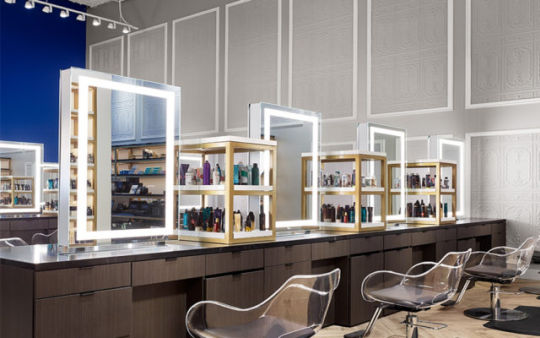By Glenn Taylor, Senior Editor

Pretty much everyone agrees that brick-and-mortar shopping must evolve if it is to capture the consumer’s eye — and wallet. There have been plenty of musings about the store of the future and the mall of the future, but I recently had an interesting chat with two executives at lauckgroup about the possible future of another physical retail concept — the “co-retailing” space.
Lauckgroup, an architecture firm with a mission to design “innovative, yet functional environments,” has created shared spaces for numerous retailers and small businesses such as Jose Luis Salon & Boutique and YETI. These retailers are seeing value in partnering with those offering similar goods and services to create a one-stop-shop for consumers.
Project Architect Lauren Field noted that Jose Luis Salon had a boutique in one of its three locations that wasn’t performing up to expectations, so they came to lauckgroup to figure out how to optimize a hybrid experience of retail and services. Located in the Domain shopping center in Austin, Texas, the new space includes a full-service hair salon (custom workstations, shampoo area, changing room and waiting area), retail space, color bar, manicure stations and various administrative/back of house areas.
“When we tie it into architecture, it really becomes creating not just a sense of spectacle, but something that you can only go and get at that space,” Field said in an interview with Retail TouchPoints. “For instance, in the salon we created a window where people can watch others get their hair done before it’s their turn. It’s a more interactive experience than going to buy a necklace or a jacket.”
Retail + Service Offerings = Wider Consumer Reach
The idea of offering an experience to add value to the shopper journey isn’t new. Still, I’m shocked that the idea of combining services and retailers within the same space hasn’t already caught on. Imagine going to a spa that featured another brand’s cosmetics, sheets or towels available for purchase. The idea isn’t so farfetched, especially if both partners do enough consumer research to assess whether the combination provides value.
“It’s about driving a new consumer pool through a variety of markets,” said Michael Horton, Senior Project Designer at lauckgroup. “There’s definitely a dedicated level of consumer from any brand, but how do you build upon that? I think about using retail as a component that would draw someone into, say, a hair salon. You may walk in thinking you’re walking into a retail store or you see something in their window that you’re really intrigued by, and then you leave making an appointment for hair, nails, etc.”
Co-Retailing Requires Chemistry Among All Parties
The co-retailing concept spawned from coworking, a growing trend over the last decade in which multiple companies, usually startups, all work in the same office. These businesses are often grouped together based on having similar cultures and missions to ensure that there is good chemistry within the space. From lauckgroup’s point of view, it appears the same needs to be done with retailers if the co-retailing concept is to truly succeed.
“It’s a careful balance of crafting a group of retailers together that have a similar emotional philosophy or motive,” Horton said in an interview with Retail TouchPoints. “But I also think it’s about creating diversity, so that the experience is assorted enough to draw shoppers in who may not typically be into your brand. Either way, the retailers will need to have a like-minded philosophy in terms of how they do business, because that’s where you draw that core value of who you are, and that’s where you start to see people making that alignment in terms of brand connectedness.”
Co-retailing has a long way to go before taking off in a major way. But as more retailers struggle to optimize their present store space, or smaller businesses seek to minimize brick-and-mortar costs, these opportunities will definitely be more enticing.






